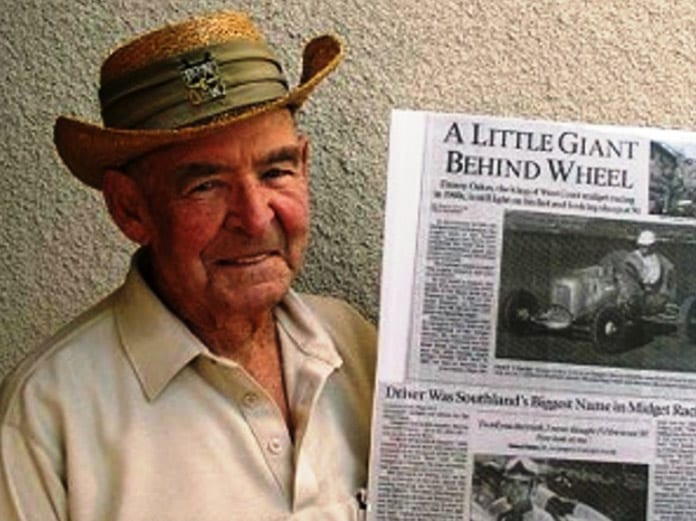“When I started racing,” recalled racer-turned-chief-mechanic Danny Oakes shortly before his death in 2007, “my mother told me, ‘Danny, you’re going to get killed in those damn race cars. You’re going to die just like all the rest of them.’
“I told her, ‘’Mom, some of them do and some don’t. I’m going to be one that don’t.’”
He didn’t.
Not only did Oakes survive, he thrived. He ran sprint cars, midgets and AAA championship cars. His forte, however, was always midgets where he won more than 150 features and three championships.
Oakes first climbed into a race car at the old Legion Ascot Speedway as a 22-year-old in 1933. “Ascot had three classes in what we called big cars then, sprint cars today,” explained Oakes. “I started out in the lower class and worked my way up. I ran pretty good there until they shut the track down because so many guys were getting killed. The Hearst newspapers got hold of it and raised so much hell that the promoters finally gave up.”
When Ascot shut down, Oakes turned to midgets, which were just ingraining themselves into the American racing consciousness. Chasing quality rides, he raced from California to the Midwest, where he won the 1937 track championship in Sioux City Iowa.
After World War II, midget racing exploded in popularity and Oakes was right in the middle of the action. He ran seven nights a week, earning $25,000 annually, equivalent to $100,000 in today’s dollars, and never ventured more than 100 miles from home.
The competition was intense. Some of the best drivers in racing were spawned during that era. California midget racing, in particular, was a driver-development hotbed with seven Indianapolis winners graduating from weekly racing there. Oakes was on the short list of the very best.
He racked up victory after victory — six consecutive during one hot streak. In 1945, he won the prestigious Turkey Night Grand Prix at Gilmore Stadium, that historic midget racing oasis that sat smack in the middle of Hollywood.
In 1947, he captured the AAA West Coast midget title. With those successes on his résumé, he earned rides on the AAA championship trail and at Indianapolis Motor Speedway. But he never made the field for the Indianapolis 500.
“I bet I drove 1,300 laps at Indianapolis, but never made the race,” admitted Oakes. “One year I was to get $500 for being Ascari’s co-driver. I showed up, they disappeared and Ferrari still owes me 500 bucks.”
Although Indy eluded him as a driver, that disappointment was mitigated when he became one of the best chief mechanics at Indy, wrenching for Johnnie Tolan, Johnny White, Bill Cheesbourg and Troy Ruttman. His most rewarding crew chief days, however, were when he worked with Jim Hurtubise in 1960; the year Herk nipped at the magical 150 mph barrier.
Still racing midgets, Oakes arrived at Indy that year as the reigning USAC Pacific Coast champion. The car was a beauty with a spectacular pearlescent lavender paint job, but car owner Ernie Ruiz wasn’t inclined to spend money on parts. So Oakes continually patched their one Offy engine just to keep Hurtubise on the track. Hurtubise responded to Oakes’ grooming with near record practice speeds.
“Jim ran a lot of laps over 147 mph, but nobody paid much attention because he was a rookie,” recalled Oakes. “But man, Herk was cocky and confident! Eddie Sachs won the pole at just over 147 and Jim goes to congratulate him. Sachs thanked him, then Jim said, ‘By the way Sachs, I’m going to blow your ass right off that pole.’
“Sachs had a big ego and like to had a fit when we ran almost 150 and shattered his record. But Sachs was also the first to congratulate Jim.”
When this writer last spoke to Oakes he was 93 years old and had just returned home from a dance with his date for the evening.
“Long Beach has the best damn dances in Southern California,” exclaimed Oakes. “And I’m a pretty good dancer, you know. I really like doing the Lindy, the Balboa and the California Swing. I scoop up a lot of gals that way.”
Oakes lived to be 96, dancing his way through life with steps of his own creation.
